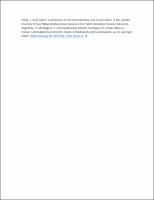Contribution to the domestication and conservation of the genetic diversity of two native multipurpose species in the Yabotí biosphere reserve, Misiones, Argentina
Date
2022-05-05Author
Niella, Fernando Omar
Tuzinkievicz, Ariel Marcelo
Buchweis, Ricardo
Bulman Hartkopf, Christian H.
Thalmayr, Peggy Noemi
González, José
Montagnini, Florencia
Sharry, Sandra
Metadata
Show full item recordAbstract
In this chapter we describe a strategy for domestication and conservation of the genetic variability of two native species of the Interior Atlantic Forest, or Selva Paranaense, Peltophorum dubium and Enterolobium contortosiliquum. Both species are leguminous trees, commonly used for forest restoration projects. In tropical and subtropical forests, tree species are vulnerable to habitat fragmentation and population reductions. The resulting negative genetic effects, such as loss of genetic variability and inbreeding depression, can affect the long-term survival of forest species, leading to their further vulnerability or extinction. While in situ strategies such as protected areas and biodiversity islands may be an option for biodiversity conservation, in practice there are many challenges to these strategies in humid subtropical ecosystems, where there is high tree species diversity and low abundance per species (0.1–1 trees/ha). Trees in remnants of forests, which can serve as biodiversity islands, must have high genetic diversity so that they can persist through time by adapting to disturbances. There is a great need to expand the genetic basis of collection of species’ propagation material, so that the germplasm available for restoration programs includes the largest possible genetic diversity. To address this need, we established short- and long-term provenance and progeny trials and a vegetative reproduction methodology to produce propagation material to ensure the genetic diversity of these two species for domestication, including for restoration and enrichment. Our results lay the foundation for the conservation of genetic variability of P. dubium and E. contortosiliquum and contribute to the design of a possible biodiversity island strategy for these species.
Collections
The following license files are associated with this item:



